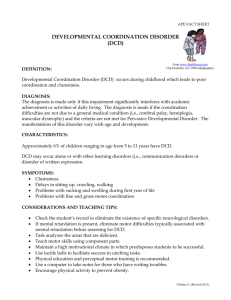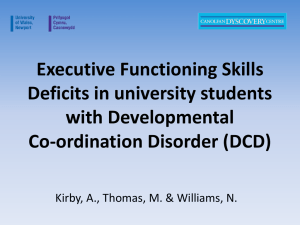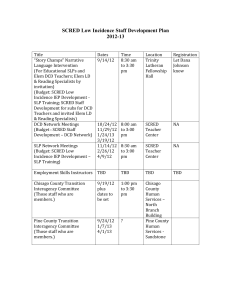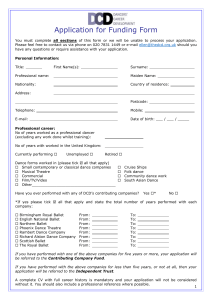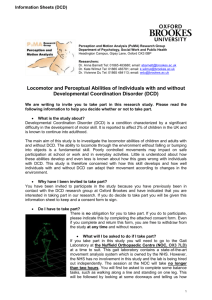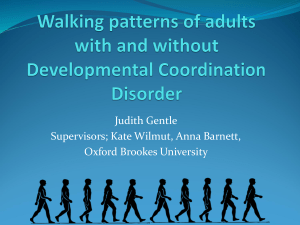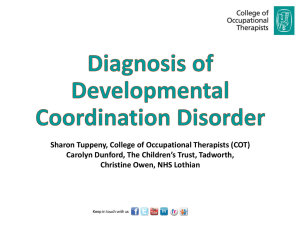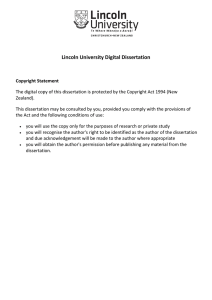Developmental Cognitive Delayed
advertisement
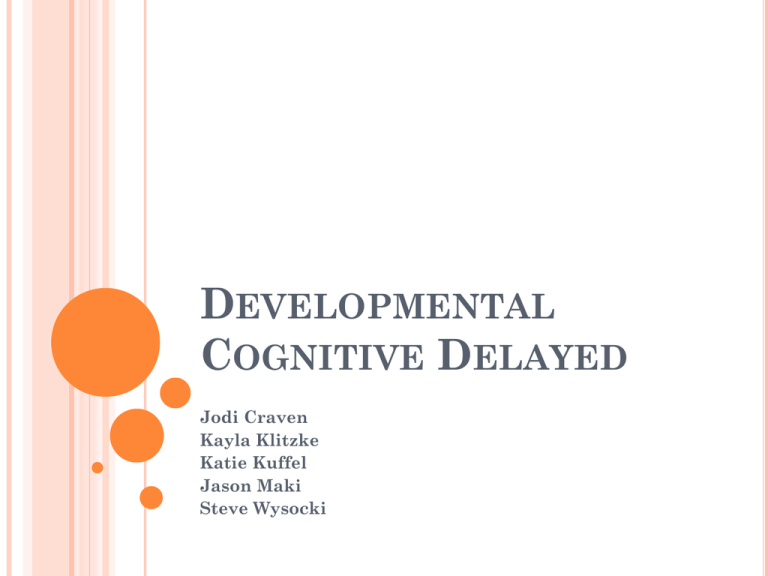
DEVELOPMENTAL COGNITIVE DELAYED Jodi Craven Kayla Klitzke Katie Kuffel Jason Maki Steve Wysocki WHY DO PROFESSIONALS USE THE TERMS INTELLECTUAL DISABILITIES AND DCD AND HOW ARE THEY DEFINED? DEFINING THE TERMS January 2007: AAMR (American Association for Mental Retardation) AAID (American Association on Intellectual and Developmental Disabilities) Intellectual Disability: Significant limitations both in intellectual functioning and in adaptive behavior as expressed in conceptual, social, and practical adaptive skills. This disability originates before age 18 Reflects two principles DEFINING DCD Developmental Cognitive Delayed The name DCD derives from Minnesota Categorize mild, moderate and severe/profound mental retardation. Involves testing through IQ scores and adaptive skills WHAT CAUSES AND CRITERIA FOR DCD? CAUSES AND CRITERIA Prenatal (before birth) Chromosomal disorders Inborn errors of metabolism Developmental disorders affecting brain formation Environmental influences Perinatal (at the time of birth) Postnatal (after birth) Biological Psychosocial http://www.ldonline.org/multimedia#video WHAT IS THE PREVALENCE OF DCD? PREVALENCE Debate between 2.7 and 1.0 prevalence Fig. 5.1. WHAT ARE THE METHODS OF ASSESSMENT FOR DCD? IQ TESTS Mild (IQ of 50 to 70) Moderate (IQ of 35 to 50) Severe (IQ of 20 to 35) Profound (IQ of 20 and less) CAUTIONS THAT NEED TO BE CONSIDERED An individual’s IQ score can change All IQ tests are culturally biased to some extent The younger the child, the less valid the results A person’s ability to live a successful and fulfilling life does not depend only on his or her IQ score ADAPTIVE BEHAVIOR PROCEDURES Intelligence that allows people to function in their everyday lives Intellectual functioning Usually involve a parent, teacher, or other professional. Social intelligence Practical intelligence ADAPTIVE BEHAVIOR Social Intelligence Ability to understand and interpret people and social interactions. Able to “read” people, or not being gullible or easily manipulated Practical Intelligence Ability to solve everyday problems Preparing meals, using transportation systems, using the internet ADDITIONAL FACTORS Assessments must also assume that limitations in individuals often coexist with strength. Level of life functioning will improve if appropriate personalized supports are provided over a sustained period. AAIDD’S LEVELS OF SUPPORT Integral to the AAIDD’S conceptualization of intellectual disabilities Intermitted (as-needed basis) Limited (time-limited, but not of an intermittent nature) Extensive (regular involvement) Pervasive (consistent, high-intensity involvement) WHAT ARE SOME OF THE PSYCHOLOGICAL AND BEHAVIORAL CHARACTERISTICS OF LEARNERS WITH DCD? MAJOR AREAS INTELLECTUAL DISABILITIES LIKELY EXPERIENCE DEFICITS Attention Harder to learn Can cause learning wrong things Difficultly allocating attention properly Memory Problem with working memory Language Limitations in language comprehension and production Exact problems dependent on cause of intellectual disability MAJOR AREAS INTELLECTUAL DISABILITIES LIKELY EXPERIENCE DEFICITS Self-Regulation Motivation Difficulties with Metacognition Experience with failure can cause belief they have little control over what happens to them Social Development Difficult to intercept social interactions Gullible LINKING GENETIC SYNDROME TO BEHAVIORAL PHENOTYPES Four Genetic syndromes Down syndrome Williams syndrome Fragile X syndrome Prader-Willi syndrome Table 5.2 (pg. 161) WHAT CAN WE DO AS TEACHERS FOR LEARNERS WITH DCD? WHAT CAN WE DO? Equal Curriculum Functional Academics General Education Curriculum Relating material to things they will do everyday Systematic Instruction Explicit directions Reinforce instructions with gestures Modeling the task WHAT CAN WE DO? Instruction in Real-Life settings Grocery shopping! Ordering in a restaurant Checks at the Bank FBA Safe environment for all learners What is causing the problem? PBIS Creating a plan to stop disruptive behavior Delivery Model Changing how a lesson is delivered Peer tutoring HOW DO PROFESSIONALS ASSESS STUDENTS WITH DCD? ASSESSING PROGRESS OF STUDENTS WITH DCD Progress Monitoring Curriculum based measurement Academic Skills Adaptive Behavior Skills Quality of Life Alternate Assessment Accommodate struggling students Schedules Presentation Response format WHAT ARE SOME THINGS TO CONSIDER WITH RESPECT TO EARLY INTERVENTION AND TRANSITION TO ADULTHOOD FOR LEARNERS WITH DCD? ASSESSMENT OF STUDENTS WITH DCD Alternate Assessments Alternative for students who may not be able to be tested with traditional methods. Testing Accommodations Includes modifications in scheduling, presentation format, and response formats. PHILOSOPHY FOR DCD CURRICULUM Educational planning is student centered, every student has the right and ability to learn Every individual is unique, take into account student needs, strengths, interests, cultural and ethnic variables, learning styles, and backgrounds. Teaching is a team effort. Support from students, parents, teachers, paraprofessionals, support staff, and administration is needed to facilitate a learning environment. Team collaboration is essential when designing an educational plan (IEP) unique to their student PHILOSOPHY FOR DCD CURRICULUM CONT. Assessment and intervention are related and ongoing. Assessment of a student current levels of ability needs to be both quantitative and qualitative. INTEGRATING MINNESOTA GRADUATION STANDARDS AND DCD Teachers job to identify gaps in curriculum for students with DCD and then identify and/or create curriculum aligned with the MN graduation standards Teachers survey determined areas of the greatest need regarding curriculum and instruction for these targeted populations Community Participation ii. Home Living/Daily Living iii. Recreation and Leisure i. INTEGRATING MINNESOTA GRADUATION STANDARDS AND DCD CONT. Community Participation General Shopping/Grocery Shopping Personal and Pedestrian Safety Restaurant Skills Home Living/Daily Living Cooking Health and Safety Hygiene Nutrition INTEGRATING MINNESOTA GRADUATION STANDARDS AND DCD CONT. Recreation and Leisure Indoor Leisure Indoor Recreation Outdoor Leisure Outdoor Recreation CREATING A LEARNING CONTINUUM Reflects the wide range of skills of students with mild to significant cognitive disabilities. Aligns these skills or performance indicators with pertinent core areas. These core learning areas and three performance levels used in the current MN alternate assessment were used to create the framework for the integrated learning continuum and these skills inventories which then align with the IEP and instructional activities created by a collaborative team. VIDEOS I Am Sam http://www.youtube.com/watch?v=7LODBr49LRw&fe ature=related I Have A Voice http://www.youtube.com/watch?v=t_0K-gPlyb0
